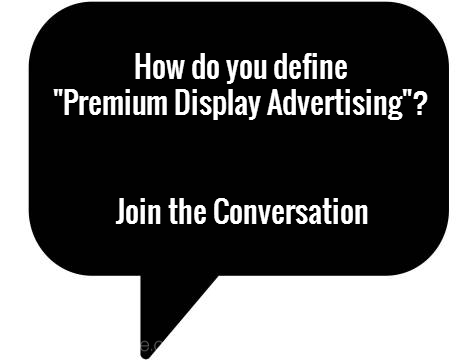
From time to time, questions pop up in the interactive advertising industry that don’t have easy answers. At the IAB Blog, we like to throw these out for debate and hear from as many voices with as many perspectives as possible. In the spirit of civility, we’ll call them IAB Conversations. Our CEO, Alice Manners, kicked off the topic of Premium Display – and ZenithOptimedia’s Jonathan Betts is adding his voice to the conversation.
I’ve spent the last fourteen years working at media agencies and therefore can write about the idea of “premium content” from an extremely focused point of view. I have spent all my professional life trying to understand how much advertisers should be paying for different types of advertising.
As wonderful as media agencies are (and I always defer to Rishad Tobaccawala on this), we’re engaged in an extremely small part of the media industry. Over time, I’ve learnt about media and publishing companies and have discovered how most of their people, investment and attention are focused on creating the content that represents their product rather than the work of monetising it. With such different backgrounds I can understand how agencies, advertisers and media companies will all have different ideas of what makes content premium.
I believe my first introduction to the idea of “premium content” was when a sales representative for a publisher used the term to justify the price they were proposing my client should pay for advertising on certain websites. I still often hear the argument that because the content around which advertising is appearing deemed to be of a higher quality then a higher price should be paid for that advertising. I have a number of issues with this argument, not least of which is the fact that the person asserting that this content is better than other similar content is the same person selling that content to advertisers and agencies.
I am someone who is very happy to enter “media buyer” as my occupation on the forms that ask for it. I think it’s this occupation that causes me to always hear “expensive” whenever someone uses the word “premium” to describe any kind of media. Facebook’s new newsfeed ad product, their “premium video” product is a case in point. Does that mean I am never prepared to pay any more for one type of advertising over another?
The short answer is “no”, but in beginning to explain the reasons behind this I think it’s useful to ask what makes anything, including media, expensive:
– There’s not much of it.
– A lot of people want it.
– It’s really valuable.
Obviously the first one shouldn’t on its own be enough to justify a higher price for digital advertising. The internet is awash with small websites that can be advertised on. Most of the owners and publishers of these websites will believe that they represent “premium content” that should justify a higher price for advertising.
John Miskelly would quote Arsene Wenger as saying that “everyone thinks they have the prettiest wife” (In case you were wondering, I have the prettiest wife). In reality, the same people who can be reached with advertising on these websites visit many other websites, both large publishers and other smaller properties. There is often an implied argument around these websites that as they are smaller advertisers should pay more to reach people on them. To be clear, advertisers are not obliged to support publishing businesses through higher prices unless they are receiving an increased benefit for the increased price they are paying.
When many people are looking to buy the same thing the price of it will always increase. Sellers of any item will look to use human nature and our own competitive instincts to increase what we are prepared to pay to secure it ahead of other people. When deciding what price to pay for anything, including media, the key is to understand what it is worth to you. If we have no clear objective measure of value it is worth remembering that we tend to over-estimate what something is worth to us. If other people seem to be prepared to pay more than you, it is less likely that they know something you don’t and more likely that they are actually competing for a short term win without understanding the long term cost.
The last of these is by far the most important. When buying media the one thing that could justify content as “premium” and a higher price would be if it actually delivered a better outcome for advertisers. I have absolutely found that for some advertisers and some campaigns there are websites that generate measurably better outcomes for advertisers. By matching the price you are prepared to pay for this kind of media you can often secure more of it and therefore increase the total return.
To believe that “premium content” should always justify a premium price is to believe that effort in always equals value out. This is not something I have found to be true in the real world.
Over time, I have come to focus on finding a way to understand whether something is worth paying a premium for based on what it delivers for my clients and I have vowed not to let other people tell me what is or isn’t premium.
Join the debate! Share your comments below.